


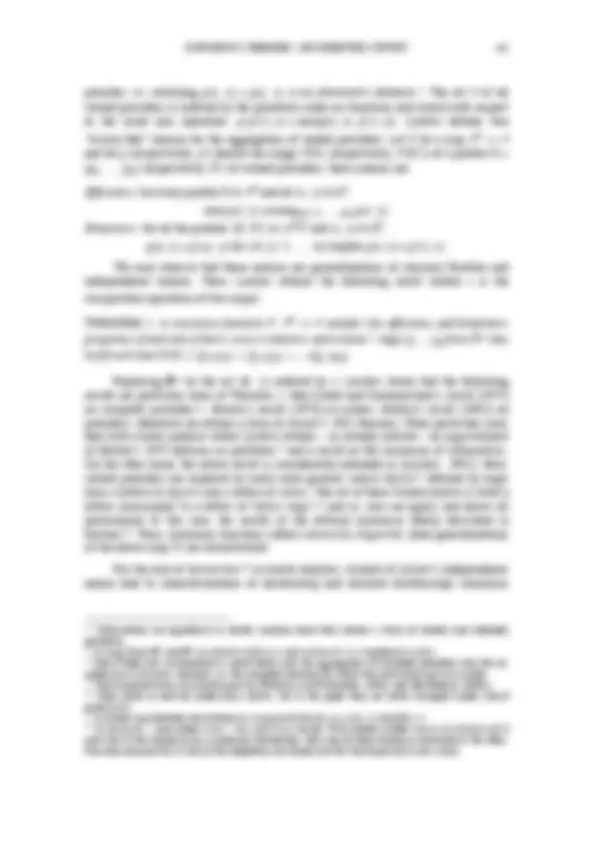

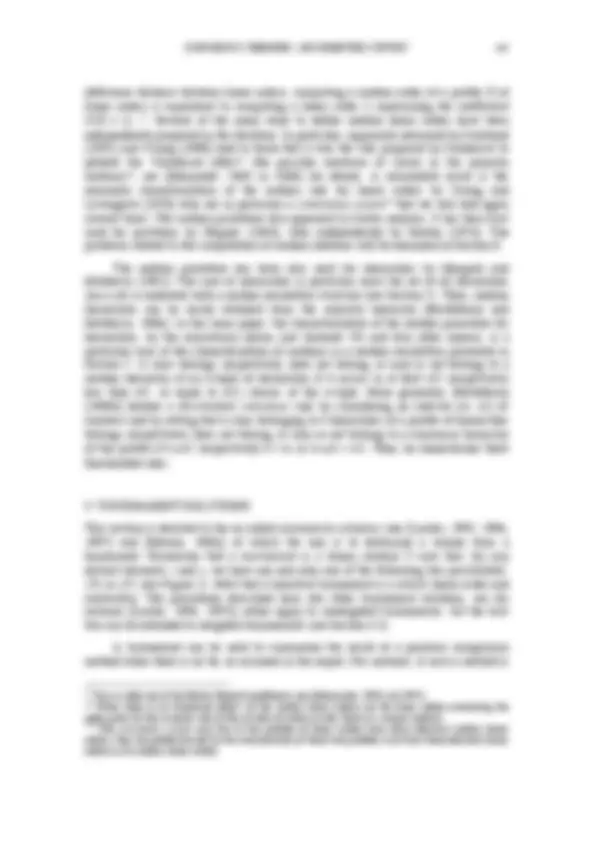
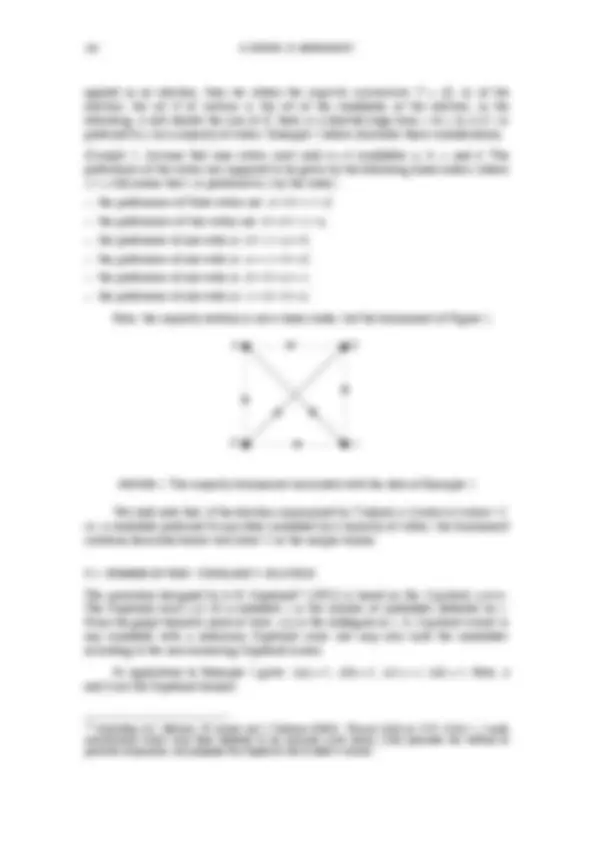
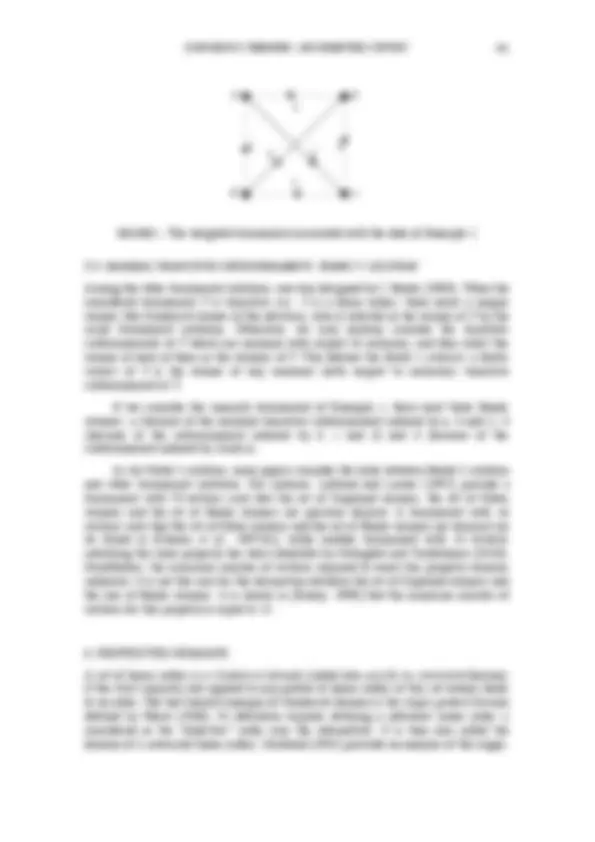
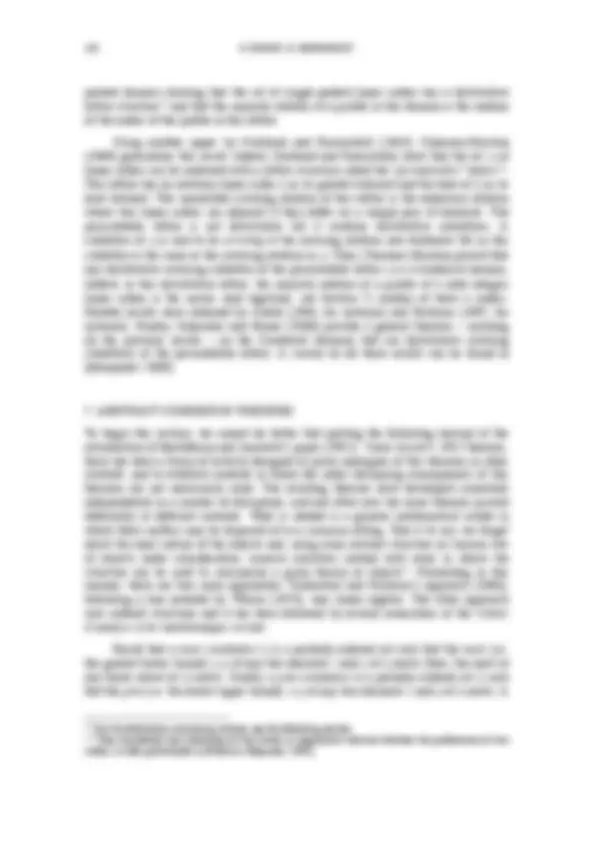
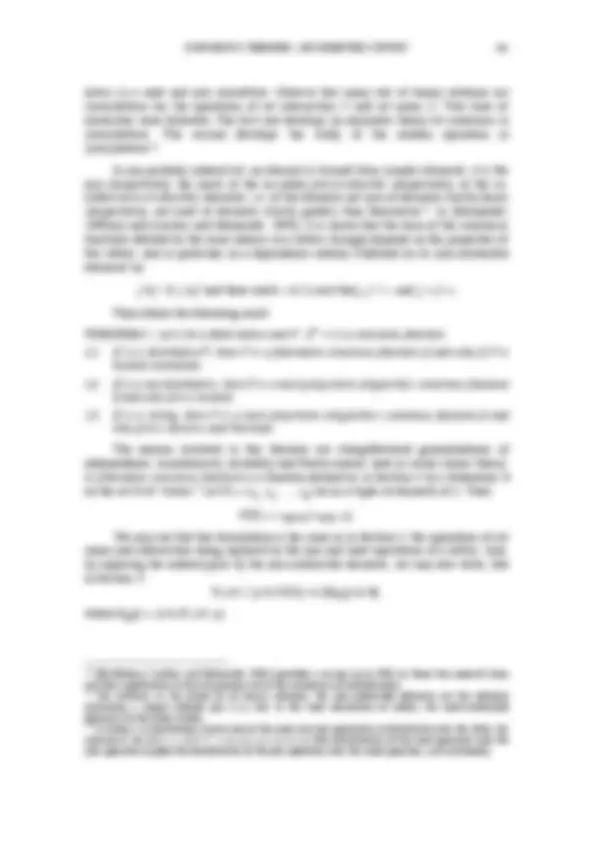














Study with the several resources on Docsity

Earn points by helping other students or get them with a premium plan


Prepare for your exams
Study with the several resources on Docsity

Earn points to download
Earn points by helping other students or get them with a premium plan
Community
Ask the community for help and clear up your study doubts
Discover the best universities in your country according to Docsity users
Free resources
Download our free guides on studying techniques, anxiety management strategies, and thesis advice from Docsity tutors
A survey of mathematical results on ranking and medians in tournaments. It includes papers by various authors such as Barthélemy, Charon, Dwork, Eckert, Fishburn, Guénoche, Hudry, Kemeny, and Monjardet. Topics covered include the minimum feedback arc set problem, median orders, and consensus functions. useful for students and researchers in mathematics, computer science, and social choice theory.
What you will learn
Typology: Study notes
1 / 29

This page cannot be seen from the preview
Don't miss anything!






















Math. Sci. hum / Mathematics and Social Sciences (
e année, n° 190, 2010 (2), p. (139-167)
Olivier HUDRY
1 , Bernard MONJARDET
2
RÉSUMÉ – Théories du consensus. Une synthèse orientée
Cet article présente une vue d’ensemble de sept directions de recherche en théorie du consensus :
résultats arrowiens, règles d’agrégation définies au moyen de fédérations, règles définies au moyen de
distances, solutions de tournoi, domaines restreints, théories abstraites du consensus, questions de
complexité et d’algorithmique. Ce panorama est orienté dans la mesure où il présente principalement –
mais non exclusivement – les travaux les plus significatifs obtenus – quelquefois avec d’autres
chercheurs – par une équipe de chercheurs français qui sont ou ont été membres pléniers ou associés du
Centre d’analyse et de mathématique sociale (CAMS).
MOTS-CLÉS – Complexité, Demi-treillis à médianes, Distances, Domaines restreints, Médiane,
Règles d’agrégation, Résultats arrowiens, Solutions de tournoi, Théories du consensus, Valuations
inférieures
SUMMARY – This article surveys seven directions of consensus theories: Arrowian results,
federation consensus rules, metric consensus rules, tournament solutions, restricted domains, abstract
consensus theories, algorithmic and complexity issues. This survey is oriented in the sense that it is
mainly – but not exclusively – concentrated on the most significant results obtained, sometimes with other
researchers, by a team of French researchers who are or were full or associate members of the Centre
d’analyse et de mathématique sociale (CAMS).
KEYWORDS – Aggregation rules, Arrowian results, Complexity, Consensus theories, Lower
valuations, Median, Median semilattice, Metric consensus rules, Restricted domains, Tournament
solutions
Let us specify the contents of this paper. By consensus theory , we mean any theory
dealing with a problem where several “objects” must be merged into one (or several)
“consensus object(s)” of the same or of similar nature that in some sense represent(s)
them at best. This type of problem appears first with the problem of means in statistics.
Here the objects are numbers (the elements of a statistical series) and the aim is to find
a number summarizing this series as well as possible (classical answers are the
arithmetical mean, the median or the mode). In social choice theory and multiple
1 Télécom ParisTech, 46, rue Barrault, 75634 Paris Cedex 13, hudry@enst.fr. O. Hudry’s research was
supported by the ANR project “Computational Social Choice” n° ANR- 09 - BLAN- 0305 - 03.
2
Centre d’Économie de la Sorbonne, Université Paris I Panthéon Sorbonne, Maison des Sciences
Économiques, 106 - 112 boulevard de l’Hôpital, 75647 Paris Cedex 13, et CAMS, EHESS,
Bernard.Monjardet@univ-paris1.fr
140 O. HUDRY, B. MONJARDET
criteria decision aid, the objects can be preferences expressed by voters or through
criteria. These preferences can be modelled by – crisp or fuzzy – binary relations like –
crisp or fuzzy – orders (of various kinds); they can also be represented by utility
functions. One can also consider the case where voters’ preferences are expressed via
choice functions. In cluster analysis, the objects to aggregate can be classifications, like
partitions (or, equivalently, equivalence relations) or hierarchies (also called n - trees).
They can also be functions like ultrametrics. In biomathematics, the objects can be
unrooted trees or molecular sequences. In computer science, they can be rankings given
by Web search engines. Merging symbolic objects is a topic of artificial intelligence.
There is a large amount of practices and literature in sport to aggregate the scores given
by judges (or obtained on several criteria) on the performances of the athletes. Finally,
the recently largely developed topic of “judgment aggregation” appears at least as soon
as 1785 with Condorcet’s Essai sur l’application de l’analyse à la probabilité des
décisions rendues à la pluralité des voix [1785].
This survey deals with seven main directions in consensus theories that will be
examined in the following sections.
desirable properties to an aggregation function may lead to a very unsatisfactory
rule, namely a “dictatorship”, in which the consensus object is the object provided by
the “dictator”
3
. In fact, if we add, as a condition for the rule, that it must not be
dictatorial or – more generally – “oligarchic”, one often gets impossibility results.
Since then, many other impossibility results have been obtained from this
“axiomatic” approach.
majority rule promoted by Condorcet. In the majority rule applied to the preferences
of voters, an alternative x is collectively preferred to another alternative y if a
majority of voters prefers x to y. Now, this rule is extended by replacing the family
of usual majorities by a family (called federation) of generalized majorities. For
instance, we can take the family of all the subsets of voters with a size greater than
or equal to a given integer q , obtaining thus the so-called quota rules. But like the
majority rule, these federation rules can lead to unsatisfactory consensus objects.
Recall that the majority rule applied to preferences can lead to an “effet Condorcet”
(see Example 1 in Section 5), i.e. to cycles a > b > c > a in the collective preference,
where x > y means that x is preferred to y by a majority.
all Arrow’s axioms and especially the independence axiom, many rules are available
and in particular the metric rules. To define such a rule, the set of objects is made a
metric space by introducing a notion of distance between (any) two objects. Then,
based on this distance, we define a remoteness function between an n - tuple of these
objects and any object. The consensus objects of an n - tuple are those minimizing this
remoteness. Section 4 develops particularly the most known metric rule, namely the
so-called median procedure.
elements x and y , we have one and only one of the following two possibilities: x is
preferred to y according to T ( xTy ) or y is preferred to x according to T ( yTx ). A
3
In fact, such a dictator is called an absolute dictator and it is obtained when the preferences are linear
orders. In Arrow’s theorem on complete preorders, the dictator imposes only his strict preference (and
not his indifference) between two alternatives.
142 O. HUDRY, B. MONJARDET
Theory in Group Choice and Biomathematics [2003]. An older survey for the consensus
of classifications is [Leclerc, 1998]. A recent survey on the main aspects of the median
procedure is [Hudry, Leclerc, Monjardet and Barthélemy, 2009], whereas related
surveys on the linear ordering problem are [Charon and Hudry, 2007a and 2010].
Finally, a survey on the complexity of voting procedures is [Hudry, 2009(a)].
Remark. Unless stated otherwise, all the mathematical objects considered in this paper
are finite.
The “axiomatic” approach initiated by Arrow for complete preorders
8 was used for
many other objects. As soon as 1952, Guilbaud [1952] uses it for judgment aggregation
(see Section 7). Brown [1975] uses it for orders and Mirkin [1975] for partitions.
Barthélemy [1982] uses it when the domain and the codomain of the aggregation
function are sets of orders. He assumes that the domain is sufficiently large, in the sense
that, for any triple of alternatives, it contains all the possible orders (except maybe the
trivial one). Then he shows that when this domain is included in the codomain, the only
aggregation functions satisfying the independence condition
9 and the weak Pareto
principle
10 are the absolute dictatorships or the absolute oligarchies
11 .
We said above that the preferences of an individual can also be expressed by a
choice function. The aggregation of choice functions was first studied by the Russian
school (Aizerman, Aleskerov, Malishevsky…; see for instance [Aleskerov, 1999]).
Monjardet and Raderanirina [2004] study the latticial structure of some significant
classes of choice functions. Then, using the latticial approach presented below in
Section 7, they obtain axiomatic results on the aggregation of choice functions in these
classes.
In cluster analysis, Mirkin [1975] was the first to use the axiomatic method for
the case of partitions and to obtain an oligarchic result. His result was improved by
Leclerc [1984] as a by-product of his significant theorem on the consensus of valued
preorders. A valued preorder (or valued quasi-order ) on a set X is a map p : X
2 → R
satisfying, for all ( x , y , z ) ∈ X
3 , p ( x , z ) ≤ max( p ( x , y ), p ( y , z )) and, for every x ∈ X , p ( x ,
x ) = 0. So, the valued preorders are – under duality – identical to the fuzzy preorders
satisfying maxmin transitivity [Zadeh, 1971]. On the other hand, a symmetric valued
8 A complete preorder R (called ordering by Arrow and also called weak order, weak ordering, complete
pre-ordering, complete quasi-ordering, linear preorder, ranking, etc.) is a complete (we must have xRy or
yRx ) and transitive ( xRy and yRz imply xRz ) binary relation. An antisymmetric ( xRy and yRx imply x = y )
complete preorder is a linear order. An order is a reflexive ( xRx ), antisymmetric and transitive binary
relation; so, an order is a linear order if and only if it is complete.
9 The independence condition says that if the preferences restricted to two alternatives of two profiles are
the same, then the collective preference for these profiles on these alternatives must be the same. This
condition (with some variants) can be stated for any consensus function.
10 The weak Pareto principle says that the aggregation function must preserve the unanimous preferences
of the voters.
11
In an absolute oligarchic rule , the consensus object is completely determined only by some voters. For
instance, when the objects are orders, the consensus object is the intersection of the orders given by these
voters (i.e. their unanimous preferences).
CONSENSUS THEORIES. AN ORIENTED SURVEY 143
preorder, i.e. satisfying p ( x , y ) = p ( y , x ), is an ultrametric distance
12
. The set V of all
valued preorders is ordered by the pointwise order on functions and closed with respect
to the usual join operation: p ∨ p ′( x , y ) = max( p ( x , y ), p ′( x , y )). Leclerc defines two
“Arrow-like” axioms for the aggregation of valued preorders. Let F be a map V
n
and let p (respectively, p ′) denote the image F (Π) (respectively, F (Π′)) of a profile Π =
( p 1
, …, p n
) (respectively, Π′) of valued preorders; these axioms are:
Efficiency : for every profile Π ∈ V
n
and all ( x , y ) ∈ X
2 ,
max p ( x , y ) ≤ max i ∈{1, 2, …, n }
p i
( x , y ).
Binariness : for all the profiles (Π, Π′) ∈ (V
n
2 and ( x , y ) ∈ X
2 ,
p i
( x , y ) = p ′ i
( x , y ) for i ∈ {1, 2, …, n } implies p ( x , y ) = p ′( x , y ).
We may observe that these axioms are generalizations of classical Paretian and
independence axioms. Then, Leclerc obtains the following result (where º
is the
composition operation of two maps):
THEOREM 1. A consensus function F : V
n
→ V satisfies the efficiency and binariness
properties if and only if there exist n reductive and isotone
13 maps f 1
,…, f n
from R
+ into
itself such that F( Π ) = (f 1 º
p 1
) ∨ (f 2 º
p 2
) ∨ … ∨ (f n º
p n
Replacing R
by the set {0, 1} ordered by <, Leclerc shows that the following
results are particular cases of Theorem 1: Mas-Collel and Sonnenschein’s result [1972]
on complete preorders
14 , Brown’s result [1975] on orders, Mirkin’s result [1981] on
preorders. Moreover he obtains a form of Arrow’s 1951 theorem. Other particular cases
deal with cluster analysis where Leclerc obtains – as already noticed – an improvement
of Mirkin’s 1975 theorem on partitions
15 and a result on the consensus of ultrametrics.
On the other hand, the above result is considerably extended in [Leclerc, 1991]. Here,
valued preorders are replaced by much more general valued objects
16 defined by maps
from a lattice of objects into a lattice of values. The set of these valued objects is itself a
lattice (isomorphic to a lattice of Galois maps
17 ) and so, one can apply, and above all
particularize to this case, the results of the latticial consensus theory described in
Section 7. Then, consensus functions called extensively oligarchic (dual generalizations
of the above map F ) are characterized.
For the case of hierarchies
18 in cluster analysis, variants of Arrow’s independence
axiom lead to characterizations of dictatorship and absolute dictatorships consensus
12 Ultrametrics are significant in cluster analysis since they induce a chain of nested (and indexed)
partitions.
13
A map f from R
into R
is reductive if f ( x ) ≤ x and isotone if x ≤ y implies f ( x ) ≤ f ( y ).
14
Mas-Collel and Sonnenschein’s result deals with the aggregation of complete preorders into the so-
called quasi-transitive relations, i.e. the complete relations for which the asymmetric part is an order.
15 This improved form was found again by [Fishburn and Rubinstein, 1986]; see [Barthélemy 1988a].
16 They could as well be called fuzzy objects , but in the paper they are rather strangely called valued
preferences.
17
A Galois map between two lattices is a map f such that f ( x ∨ y ) = f ( x ∧ y ) and f (0) = 1.
18
such that if two classes have a nonempty intersection, then one of these classes is contained in the other.
One also assumes that E and all the singletons are classes and that the empty set is not a class.
CONSENSUS THEORIES. AN ORIENTED SURVEY 145
M is reduced to a singleton { i }, i.e. if the filter is an ultrafilter , we obtain an (absolute)
dictatorship, since the consensus relation is R i
Guilbaud [1952] was the first to use federations (called families of generalized
majorities by him). He stated an Arrowian theorem for judgment aggregation (see
Section 7) by essentially proving that Arrowian conditions required for a federation
consensus rule imply that the federation is an ultrafilter
20 .
In [Monjardet, 1978], federation
21 rules are used for tournaments. The problem of
aggregating tournaments occurs for instance with the paired comparison method in
socio-psychology. When a subject is asked to give all his binary preferences between
some objects, the result can contain intransitivities , as a > b > c > a. So, when the
subject must express strict preferences (indifference and abstention are excluded), the
result is a tournament. In [Monjardet, 1978], several axiomatically-defined aggregation
rules on tournaments are characterized as rules defined by federations. As a by-product,
one obtains a Galois connexion
22
showing the duality between Arrow’s theorem and
Ward’s theorem
23
for linear orders.
The general problem with the federation consensus rules is that the consensus
object may be unsatisfactory. First, it may not belong to the class of considered objects
(for instance, the majority rule on linear orders may produce a non-transitive
tournament). But, even if it is not the case, the consensus object may remain
unsatisfying. For instance, in cluster analysis, the unanimity rule applied to hierarchies
is often called the strict rule. This rule, like more generally other quota rules, gives a
hierarchy but which may miss some structural features of the aggregated hierarchies
and, in particular, the fact that two elements of the set E of elements to classify may be
put together in all the hierarchies before to be joined by a third element. Then, one
would wish that these two elements appear in some cluster of the consensus hierarchy
not containing the third element. The celebrated Adams’s rule [Adams, 1986] achieves
this wish. First, Adams associates a nesting relation on the subsets of E with any
hierarchy and conversely. Then, given a profile of hierarchies, the consensus hierarchy
is this one corresponding with the intersection of all the nesting relations associated
with the hierarchies of the profile. The one-to-one correspondence between hierarchies
and nesting relations has been generalized to a one-to-one correspondence between
Moore families
24 and overhanging relations by Domenach and Leclerc [2004(a),
2004(b), 2007]. The problem to aggregate Moore families occurs in several fields and
raises the same type of difficulties as the above problem for hierarchies. Then, Adams’s
method can be generalized by using quota rules on the overhanging relations associated
with a profile of Moore families. But the obtained relation is not necessarily an
20 For the use of ultrafilters in social choice theory, see [Monjardet, 1983].
21
Here a federation is called a family of majorities and it satisfies an additional condition: a coalition
belongs to the family F if and only if the complementary coalition does not belong to F.
22 For all terms of order or lattice theories not defined here, see for instance [Davey and Priestley, 2001]
and [Caspard, Leclerc and Monjardet, 2007].
23 A cyclic triple of preferences on three objects a, b, c is a triple such as: a > b > c , b > c > a and
c > a > b. Ward’s theorem says that majority rule applied on linear orders belonging to a set of linear
orders always provides an order if and only if this set does not contain cyclic triples.
24
A Moore family (also called a closure system ) on a set N is a family F of subsets of N (the closed sets )
closed by intersection and containing the set N. By adding the empty set to a hierarchy, this one becomes
a closure system.
146 O. HUDRY, B. MONJARDET
overhanging relation. Nevertheless, one can show that there exists at most a unique
overhanging relation containing this relation and satisfying another desirable condition
[Leclerc, 2004], [Domenach and Leclerc 2004(b)]. Now, when this overhanging
relation exists, one can come back to a Moore family. If one applies this method to
aggregate Moore families of a special class, one still needs to obtain a Moore family of
the same type. It is shown in [Domenach, 2010] that it is indeed the case for some
classes of Moore families.
The most known metric rule is the so-called Kemeny rule defined for complete
preorders in [Kemeny, 1959]. Kemeny defines a measure of distance between two
complete preorders as the number of their disagreements
25
. This measure is actually a
distance since it is nothing else than the well-known symmetric difference distance.
Then, Kemeny defines the remotenes s between a profile of complete preorders and a
complete preorder as the sum of the distances between this complete preorder and those
in the profile. Finally, he defines the consensus complete preorders of a profile as the
complete preorders minimizing the remoteness to this profile. His paper contains also
an axiomatic characterization of the symmetric difference distance between complete
preorders. Barthélemy [1979, see also 1981] improves it in a paper containing
characterizations of this same distance for the most used sets of relations and where he
also shows the independence of the considered axioms.
Any set of binary relations (and, more generally of sets) endowed with the
symmetric difference distance becomes a metric space. In a metric space, a “point”
minimizing the sum of its distances to an n - tuple of other points is classically called a
( metric ) median of these points. Then, Kemeny’s rule is a particular case of what has
been called the median procedure
26
to define consensus objects. In the case of arbitrary
binary relations, this procedure has been independently proposed by Barbut [1967] and
Mirkin [1974]. Both authors observe that the majority (or Condorcet) relation of a
profile of (arbitrary) relations is a median of this profile. But, this procedure is a
“multiprocedure” in the sense that a profile has generally several medians. And
generally the computation of median objects amounts to solve difficult combinatorial
optimisation problems (see Section 8).
Consider first the case where the objects are linear orders. In this case, one can
observe that the median procedure can be defined in many other ways (sixteen are
presented in [Monjardet, 1990(b)]). For instance, in statistics, a classic concordance
coefficient between the linear orders of a profile is the so-called Kendall-Ehrenberg’s
coefficient U. This coefficient is formed by the mean of Kendall’s tau on the pairs of
linear orders of the profile. But since Kendall’s tau is a normalization of the symmetric
25 Two complete preorders have two (respectively, one) disagreement(s) for the pair { x , y } if one prefers
x to y and the other y to x (respectively, is indifferent between x and y ). In the case of linear orders where
the number of disagreements can only be equal to 0 or 2 for each pair, half this distance normalized
between – 1 and +1 is Kendall’s tau, well-known to the statisticians [Kendall, 1938].
26
For a survey on the median procedure up to 1988, see [Barthélemy and Monjardet, 1981 and 1988].
For historical details on the median in several (discrete or not) metric spaces, see [Monjardet, 1991 and
2008].
148 O. HUDRY, B. MONJARDET
applied in an election, then we obtain the majority tournament T = ( X , A ) of the
election: the set X of vertices is the set of the candidates of the election; in the
following, n will denote the size of X ; there is a directed edge from x to y in A if x is
preferred to y by a majority of voters. Example 1 below illustrates these considerations.
Example 1. Assume that nine voters must rank n = 4 candidates a , b , c , and d. The
preferences of the voters are supposed to be given by the following linear orders (where
x > y still means that x is preferred to y by the voter):
Here, the majority relation is not a linear order, but the tournament of Figure 1.
a b
c d
FIGURE 1. The majority tournament associated with the data of Example 1
We shall note that, if the election summarized by T admits a Condorcet winner C ,
i.e. a candidate preferred to any other candidate by a majority of voters, the tournament
solutions described below will select C as the unique winner.
The procedure designed by A.H. Copeland
30 [1951] is based on the Copeland scores.
The Copeland score s ( x ) of a candidate x is the number of candidates defeated by x.
From the graph theoretic point of view, s ( x ) is the outdegree of x. A Copeland winner is
any candidate with a maximum Copeland score (we may also rank the candidates
according to the non-increasing Copeland scores).
Its application to Example 1 gives: s ( a ) = 2, s ( b ) = 2, s ( c ) = 1, s ( d ) = 1. Here, a
and b are the Copeland winners.
30
According to I. McLean, H. Lorrey and J. Colomer [2008], “Ramon Llull (ca 1232-1316) (...) made
contributions which have been believed to be centuries more recent. Llull promotes the method of
pairwise comparison, and proposes the Copeland rule to select a winner.”
CONSENSUS THEORIES. AN ORIENTED SURVEY 149
Slater solution [1961] allows also ranking the candidates. It consists in reversing a
minimum number of arcs of T in order to obtain a transitive tournament O , i.e. a linear
order, and then to consider the winner of O as a Slater winner. More precisely, let O be
a linear order defined on X. We define the distance θ( T , O ) between T and O as the
number of arcs of T which have a different orientation in O (note that this distance is
half the symmetric difference distance of Section 4 applied to the relations T and O ). A
Slater order of T is a linear order O * minimizing θ( T , O ) over the set of the linear
orders O defined on X. A Slater winner of T is the winner of any Slater order of T. We
note i ( T ) the minimum number of arcs that must be reversed in T to get a Slater order
O * of T : θ( T , O *) = i ( T ); i ( T ) is called the Slater index of T.
It is easy to see that the Slater index of the tournament of Figure 1 is equal to 1:
reversing ( d , a ) is sufficient to obtain a linear order, namely a > b > c > d. In fact, we
may prove that this reversing is also necessary to obtain a linear order: thus a > b > c >
d is the only Slater order of this tournament and a is its only Slater winner.
Attention had been paid to combinatorial aspects of Slater’s solution. For
instance, the maximum values that the Slater index can take, the number of Slater
orders that a given tournament can admit, some links between Slater orders and
Hamiltonian paths, or the construction of tournaments with a given Slater index are
investigated in papers like [Barthélemy et al ., 1995], [Bermond, 1972, 1973], [Charon
and Hudry, 2000, 2003], [Hudry, 1997]. The links between Slater’s solution and other
tournament solutions have also been studied. For example, Bermond [1972] showed
that the Copeland score of a Slater winner in a tournament with n vertices is at least n /2;
this result was generalized to weighted tournaments in [Charon et al. , 1997(a)] while
[Guénoche, 1995] provides bounds for the rank of any vertex in a Slater order, still
based on the Copeland scores (or on the weights of the arcs of the considered
tournament, if this one is weighted). Bermond [1972] also exhibited a tournament with
7 vertices such that the set of Copeland winners and the one of Slater winners are
disjoint. In fact, as pointed out in [Charon and Hudry, 2007a], the minimum number of
vertices for such a situation to occur is 6. The Copeland scores may also be involved to
provide bounds of the Slater index, as in [Charon et al ., 1992(a)] and [Charon and
Hudry, 2003]. More recently, Charon and Hudry [to appear] study the distance between
Slater orders and Copeland orders (i.e., orders obtained by ranking the vertices of a
tournament T according to the non-increasing Copeland scores of T ). They show that
there exist tournaments T admitting Slater orders O S
and Copeland orders O C
such that
the distance θ( O S
C
) between these orders reaches its maximum, equal to n ( n – 1)/2,
in spite of Bermond’s [1972] result about the Copeland score of a Slater winner.
For more detailed surveys on Slater’s solution, see [Charon et al ., 1996(b)],
[Charon and Hudry, 2007, 2010] or [Laslier, 1996, 1997].
If T represents the majority tournament of a pairwise comparison method applied for
instance to an election, we may weight the arcs of T. A usual way to do this consists in
defining the weight w ( x , y ) of an arc ( x , y ) as the difference between twice the number
CONSENSUS THEORIES. AN ORIENTED SURVEY 151
a b
c d
1
1
3
3
1
1
FIGURE 2. The weighted tournament associated with the data of Example 1
Among the other tournament solutions, one was designed by J. Banks [1985]. When the
considered tournament T is transitive (i.e., T is a linear order), there exists a unique
winner (the Condorcet winner of the election), who is selected as the winner of T by the
usual tournament solutions. Otherwise, we may anyway consider the transitive
subtournaments of T which are maximal with respect to inclusion, and then select the
winner of each of them as the winners of T. This defines the Banks’s solution : a Banks
winner of T is the winner of any maximal (with respect to inclusion) transitive
subtournament of T.
If we consider the majority tournament of Example 1, there exist three Banks
winners: a (because of the maximal transitive subtournament induced by a , b and c ), b
(because of the subtournament induced by b , c and d ) and d (because of the
subtournament induced by d and a ).
As for Slater’s solution, some papers consider the links between Banks’s solution
and other tournament solutions. For instance, Laffond and Laslier [1991] provide a
tournament with 75 vertices such that the set of Copeland winners, the set of Slater
winners and the set of Banks winners are pairwise disjoint. A tournament with 16
vertices such that the set of Slater winners and the set of Banks winners are disjoint can
be found in [Charon et al. , 1997(b)], while another tournament with 14 vertices
satisfying the same property has been exhibited by Östergård and Vaskelainen [2010].
Nonetheless, the minimum number of vertices required to reach this property remains
unknown. It is not the case for the disjunction between the set of Copeland winners and
the one of Banks winners: it is shown in [Hudry, 1999] that the minimum number of
vertices for this property is equal to 13.
A set of linear orders is a Condorcet domain (called also acyclic or consistent domain)
if the strict majority rule applied to any profile of linear orders of this set always leads
to an order. The best known example of Condorcet domain is the single-peaked domain
defined by Black [1948]. Its definition requires defining a reference linear order L
considered as the “objective” order over the alternatives. It is then also called the
domain of L-unimodal linear orders. Guilbaud [1952] provides an analysis of the single-
152 O. HUDRY, B. MONJARDET
peaked domain showing that the set of single-peaked linear orders has a distributive
lattice structure
32 and that the majority relation of a profile in this domain is the median
of the orders of the profile in this lattice.
Using another paper by Guilbaud and Rosenstiehl [1963], Chameni-Nembua
[1989] generalizes this result. Indeed, Guilbaud and Rosenstiehl show that the set L of
linear orders can be endowed with a lattice structure called the “ permutoèdre ” lattice
33 .
This lattice has an arbitrary linear order L as its greatest element and the dual of L as its
least element. The unoriented covering relation of this lattice is the adjacency relation
where two linear orders are adjacent if they differ on a unique pair of elements. The
permutoèdre lattice is not distributive but it contains distributive sublattices. A
sublattice of L is said to be covering if the covering relation (see footenote 38) in this
sublattice is the same as the covering relation in L. Then, Chameni-Nembua proved that
any distributive covering sublattice of the permutoèdre lattice L is a Condorcet domain.
Indeed, in this distributive lattice, the majority relation of a profile of n (odd integer)
linear orders is the metric (and algebraic, see Section 7) median of these n orders.
Related results were obtained by Abello [1985, for instance] and Fishburn [1997, for
instance]. Finally, Galambos and Reiner [2008] provide a general theorem – unifying
all the previous results – on the Condorcet domains that are distributive covering
sublattices of the permutoèdre lattice. A survey on all these results can be found in
[Monjardet, 2009].
To begin this section, we cannot do better that quoting the following excerpt of the
introduction of Barthélemy and Janowitz’s paper [1991]: “since Arrow’s 1951 theorem,
there has been a flurry of activity designed to prove analogues of this theorem in other
contexts, and to establish contexts in which the rather dismaying consequences of this
theorem are not necessarily valid. The resulting theories have developed somewhat
independently in a number of disciplines, and one often sees the same theorem proved
differently in different contexts. What is needed is a general mathematical model in
which these matters may be disposed of in a common setting. That is to say, we forget
about the exact nature of the objects and, using some abstract structure on various sets
of objects under consideration, concern ourselves instead with ways in which the
structure can be used to summarize a given family of objects”. Proceeding in this
manner, there are two main approaches. Rubinstein and Fishburn’s approach [1986],
following a line initiated by Wilson [1975], uses linear algebra. The other approach
uses ordered structures and it has been followed by several researchers of the Centre
d’analyse et de mathématique sociale.
Recall that a meet semilattice L is a partially ordered set such that the meet (i.e.
the greatest lower bound) x ∧ y of any two elements x and y of L exists (then, the meet of
any finite subset of L exists). Dually, a join semilattice is a partially ordered set L such
that the join (i.e. the lowest upper bound) x ∨ y of any two elements x and y of L exists. A
32
For the definitions concerning lattices, see the following section.
33 They considered also sublattices of this lattice as negotiation intervals between the preferences of two
voters, an idea generalized in [Feldman-Högaasen, 1969].
154 O. HUDRY, B. MONJARDET
In case (1) of Theorem 2, the lattice is distributive, which is equivalent to say that
its dependence relation reduces to the order relation existing between its join-
irreducible elements
37
. Then, there are as many neutral, monotonic consensus functions
as there are federations (simple games) on N. But as soon as the lattice L is no longer
distributive, the same axioms reduce the class of admissible functions strongly: there
i ∈ A
x i
(which means that the only
admissible federations are those formed by the supersets of a nonempty subset of N ).
Finally, when L is strong , i.e. when the dependence relation is strongly connected, the
decisivity and Paretian axioms imply the stronger axiom of neutral monotonicity. The
above result is in fact a particular case of a more general result obtained for
semilattices.
Since first Barbut’s works [1961, 1969], the abstract latticial approach has also
been developed much for metric consensus. In this case, we have a meet (or a join)
semilattice L endowed with a distance d. Several distances are possible and the most
usual, used below, generalizes the symmetric difference distance. Axiomatic
characterizations of these distances can be found in [Barthélemy, 1979], [Monjardet,
1981] and [Barthélemy, Leclerc and Monjardet, 1986].
Let Π = ( x 1
, x 2
, …, x n
) be an n - tuple of elements of L. The remoteness of an
element x of L from Π (with respect to the distance d ) is:
R (Π, x ) = ∑ i ∈ N
d ( x , x i
A median of Π (with respect to the distance d ) is any element of L minimizing
this remoteness; it is called a Π-median. The set of Π-medians is denoted by Med L
Observe that, since there generally exist several medians, the median rule is a map from
n
to 2 L , so defining a multi-consensus rule.
On the other hand, several “majority” elements can be associated with Π,
obtained by using different forms of the majority rule. Let J (respectively, J ′) be the set
of join-irreducible (respectively, meet-irreducible) elements of L. We set:
C (Π) = { j ∈ J : |{ i ∈ N : j ≤ x
i
}| > n /2}, C ′(Π) = { j ′ ∈ J ′: |{ i ∈ N : j ′ ≥ x
i
}| > n /2},
B (Π) = { j ∈ J : |{ i ∈ N : j ≤ x i
}| ≥ n /2}, B ′(Π) = { j ′ ∈ J ′: |{ i ∈ N : j ′ ≥ x i
}| ≥ n /2}
and
In a semilattice, some of these elements may not exist_._ For the existing elements,
we have c (Π) ≤ b (Π) ≤ c ′(Π) and c (Π) ≤ b ′(Π) ≤ c ′(Π). If n is odd, we have c (Π) =
b (Π) and b ′(Π) = c ′(Π). If L is a distributive lattice , we have c (Π) = b ′(Π) and c ′(Π) =
b (Π).
The reason to consider these majority elements will become clear below. We take
as distance a straightforward generalization of the symmetric difference distance
previously used in Section 4. This generalization uses the join-irreducible
37 For any partially ordered set P , there exists a distributive lattice such that the poset of its join-
irreducible elements is isomorphic to P.
CONSENSUS THEORIES. AN ORIENTED SURVEY 155
representation of the elements mentioned above. Let x be an element of a semilattice L ;
set J x
x
). Now write, for any ( x , x ′) belonging to L
2 :
δ( x , x ′) = | J x
x ′
x
x ′
x
x ′
| = |{ j ∈ J : [ j ∈ J x
and j ∉ J x ′
] or [ j ∉ J x
and j
x ′
A meet semilattice L is said to be lower distributive if, for any x ∈ L , the lattice
{ x ′ ∈ L : x ′ ≤ x } is distributive (see footnote 36). A median semilattice [Avann, 1961] is
a lower distributive meet semilattice L in which, for all ( x 1
, x 2
, x 3
3 , x 1
∨ x 2
∨ x 3
exists
as soon as the three elements x 1
∨ x 2
, x 1
∨ x 3
and x 2
∨ x 3
all exist. In such a median
semilattice, the element ( x ∧ x ′ )∨( x ′ ∧ x ″ )∨( x ″ ∧ x ) exists for any ( x , x ′, x ″) ∈ L
3
and is
called the (algebraic) median of these three elements. Then, it can be shown that, for
Π = ( x 1
, x 2
, …, x n
), the (algebraic) median of Π, i.e. the element c (Π), also exists (but
not necessarily the element b (Π)). If a median semilattice is a lattice, it is a distributive
lattice. When L is a median semilattice, the medians of a profile with respect to the
metric δ can be easily obtained from the majority elements, as shown in the result below.
This characterization of medians with respect to δ in a median semilattice [Bandelt and
Barthélemy , 1984] generalizes a series of results on medians in distributive lattices
[Birkhoff and Kiss, 1947], [Barbut, 1961], [Monjardet, 1980]:
THEOREM 3. Let L be a median semilattice and Π ∈ L
n be a profile of L. If n is odd,
then c( Π ) is the unique Π - median; if n is even, then the set of all Π - medians with
respect to the symmetric difference distance metric δ is Med L
B( Π ) and ∨ K exists}.
In particular, in a distributive lattice, the set of all Π-medians is the median
interval [ c (Π), b (Π)] = { x ∈ L : c (Π) ≤ x ≤ b (Π)} [Monjardet, 1980]. If n is odd, c (Π) =
b (Π) is the unique median. The fact that these properties characterize distributive
lattices can be obtained from the following more general result due to Leclerc [1990],
where the distance used is the distance d sp
of the shortest path
38 :
THEOREM 4. A lattice is upper semimodular
39 if and only if, for any profile Π and for
any Π - median m (with respect to the distance d sp ), the inequality c( Π ) ≤ m holds.
Observe that this result gives a lower bound for medians (with respect to d sp
) in
the case of an upper semimodular lattice. This is significant since, except for the median
semilattice case, medians may be difficult to compute. Continuing this line of research,
Leclerc gave many results on medians with respect to other metrics and other
semilattices. A usual way to define metrics on semilattices (and more generally on
partially ordered sets) is to use valuations. Let v be a strictly isotone (i.e. x < y implies
v ( x ) < v ( y )) real map on a meet semilattice L. The map v is a lower valuation if it satisfies
the following property whenever x ∨ y exists:
38 Let p be the covering relation of L : x p y whenever x ≤ z < y implies x = z. Setting xEy if x p y or y p x
defines an undirected graph ( L , E ). The distance d sp
between x and y is the minimum length of a path
between x and y in this graph.
39
A lattice L is upper (respectively, lower ) semimodular if, for all ( x , y , z ) ∈ L
3
, x ∧ y p x and x ∧ y p y
imply (respectively, are implied by) x p x ∨ y and y p x ∨ y where p denotes the covering relation of L.
A lattice is modular if it is upper and lower semimodular. A distributive lattice is modular (but the
converse is false).
CONSENSUS THEORIES. AN ORIENTED SURVEY 157
exists, we have v ( x ∧ y ) + v ( x ∨ y ) = v ( x ) + v ( y ). Then, he extends the previous result on
medians (with respect to the distance δ) in median semilattices to this case:
THEOREM 8. Let L be a finite lower distributive semilattice and Π ∈ L
n be a profile
such that c (Π) exists, and let v be a weight valuation on L. Then, if n is an odd number,
c (Π) is the unique median. If n is even, the set of all the Π - medians with respect to the
metric d v
is Med d v
Observe that, in a lower distributive semilattice and contrary to a median
semilattice, the element c (Π) may not exist. Nevertheless, it is possible to give a way to
search medians in this case.
Obviously, all the previous results can be applied to “concrete” objects. It suffices
that the set of all the considered objects can be endowed with a (semi)latticial structure.
It is the case for many sets of relations (like orders or equivalences), for many sets of
classifications (like partitions or hierarchies), for many sets of maps (like fuzzy
preorders, choice functions or ultrametrics). Then, to apply the previous results, it
suffices to determine the latticial properties of these ordered sets. In some cases, one
can also obtain specific results. The example below illustrates such a situation.
Let O be the set of all the orders defined on a set X endowed with the inclusion
relation. The partially ordered set O is a lower locally distributive meet semilattice
42
[Leclerc, 2003]. Using the above results on medians with respect to a weight metric, we
can for instance obtain that the covering relation of any median order of a profile of
orders is formed of majority ordered pairs (a generalization of a result on median linear
orders in [Monjardet, 1973]). On the other hand, a classic and desirable property for a
consensus rule is the Pareto property, requiring that the consensus order keeps the
unanimous preferences. In the latticial context, this property translates into the
following form. A consensus rule on a semilattice L has the Pareto property if for any
profile Π = ( x 1
, x 2
, …, x n
n
i ∈ N
x i
≤ m holds. In
[Leclerc, 2003], it is shown that the median rule for orders with respect to the
symmetric difference distance δ satisfies the Pareto property but that this property is not
satisfied with respect to other weight metrics. The same is true for partitions
[Barthélemy and Leclerc, 1995]. Still in [Leclerc, 2003], many similar results may be
found concerning the Pareto property for various metrics and various semilattices.
Observe for instance that Leclerc’s characterization of upper semimodular lattice given
above (by the inequality c (Π) ≤ m for any Π-median m , with respect to the distance δ)
shows that in this case the median rule has the Pareto property (a result first obtained by
Barthélemy [1981]). Barthélemy [1976] proves Paretian properties for metric
procedures defined on large classes of binary relations by remoteness functions
satisfying monotonicity properties.
Coming back to the axiomatic approach, we can search to provide an axiomatic
characterization of median rules. As already said, the first such result was obtained by
Young and Levenglick [1978] for the case of the median rule (with respect to the
symmetric difference distance δ) for linear orders. Barthélemy and Janowitz [1991]
characterized the median rule (with respect to δ) on median semilattices by the
42
A lower locally distributive meet semilattice is a meet semilattice such that all its principal ideals ( x ]
are lower locally distributive lattices. A lower locally distributive lattice can be defined for instance by
the fact that for any x ∈ L , the interval [∧{ y ∈ L : y p x }, x ] is a Boolean lattice.
158 O. HUDRY, B. MONJARDET
consistency property (see footnote 29) and four other properties. Their result was
improved by McMorris, Mulder and Powers [2000] who use only the consistency
property and two other properties.
Another abstract approach to the aggregation problem was initiated by Guilbaud
[1952] as early as 1952. Indeed, in his paper “ Les théories de l’intérêt général et le
problème logique de l’agrégation ”, Guilbaud considers the aggregation of individual
opinions (or judgments) consisting of the answers “yes” or “no” to a series of questions.
In other terms, the opinion of an individual (for instance, a judge) is the set of
valuations 0 or 1 given to a set of binary propositions. When these propositions are
logically connected, it is assumed that these valuations respect the connexions. For
instance, if proposition p implies proposition q , then an answer “yes” to p implies an
answer “yes” to q. So, Guilbaud searches independent and neutral aggregation rules
such that the collective judgment always respects the same connexions as the individual
judgments. And the answer is that they are only the dictatorships for which the
collective judgment is the judgment of one individual. A reconstruction of Guilbaud’s
proof and historical considerations on his paper can be found in Eckert and Monjardet
(2010). One can observe that in this paper Guilbaud appears as a precursor of the so-
called judgment aggregation considerably developed in the last years.
As said in the introduction, the algorithmic complexity of a method plays an important
role. It is usual to distinguish between polynomial problems and NP-hard ones. Let us
remind that a problem is polynomial when there exists a polynomial method to solve it.
On the opposite, the practical consequence of the NP-hardness of a problem is that none
polynomial method is known to solve it exactly; so, solving such a problem exactly
may require a CPU time which may increase exponentially with the size of the
instances to solve (for more details upon the theory of algorithmic complexity and the
theory of NP-completeness, see for instance [Barthélemy, Cohen and Lobstein, 1996]
or [Garey and Johnson, 1979]).
The computation of median linear orders is a problem which can be modelled as a
particular case of the linear ordering problem
43 and so as a 0-1 linear program (see, for
instance [Reinelt, 1985] or [Charon and Hudry, 2010]). It has been shown to be NP-
hard (see below). This fact induces that exact methods giving the median orders do not
allow solving large (with respect to the number of alternatives) problems
44
. These
methods are mainly based on branch and bound methods. For instance, Bermond and
Kodratoff [1976], then Barthélemy, Guénoche and Hudry [1989] provide branch and
bound algorithms later improved with the help of some theoretical results in [Charon et
al. , 1992(b), 1996(a), 1997(a), 2006(a)]. When these methods cannot be applied,
43 This problem includes also a representation of Slater’s problem. This one consists in searching a linear
order fitting a tournament at best. And indeed the search of a median order can be stated as the search of
a linear order fitting a weighted tournament at best (see Section 5).
44 It is difficult to give a specific value, since the performances of the algorithms much depend on the
considered instances and on the used computer. For example, the software available at the Web address
http://www.enst.fr/~charon/tournament/median.html can deal with instances simulating some real data
with 100 candidates in about 1 second. Random instances seem more difficult to solve (see [Charon and
Hudry, 2006(a)]).